
Death
Though funerary rites varied widely across the ancient Mediterranean, from burial of the whole body or cremated remains to mummification, all the cultures explored here took great care in preparing the body for death and the afterlife.
The objects in this part of the exhibit focus on representations of the human body in death, primarily in the form of coffins, masks, and urns. Some of these objects are life-like while others are highly stylized— you may have to look closely to see human features.
More life-like representations might seem truer to life, but this is misleading. Funerary portraits capture how the family of the deceased wanted them to be remembered. Gender is often signified in funerary art, but other aspects of a person’s identity are harder to pin down. Often all we know for sure is that the deceased had enough wealth to secure a permanent memorial.
 Painted Funerary Portrait An eye seems to peer out of the past in this striking fragment. Though slight, it preserves the bold brushstrokes of Greco-Roman painting, a style that became popular later in Egypt’s history. Like many painted portraits, the face of the deceased has become separated from a larger context, which may have included pictures of food, clothing, and other items for use in the afterlife, as well as scenes of the deceased’s burial and hoped-for resurrection. Like the gold paint used in a burial portrait nearby, the gold laurel wreath associates the deceased with the gods, whose company they hope to share. Roman Egypt Wood and paint 1–300 CE 1912.01.0030
Painted Funerary Portrait An eye seems to peer out of the past in this striking fragment. Though slight, it preserves the bold brushstrokes of Greco-Roman painting, a style that became popular later in Egypt’s history. Like many painted portraits, the face of the deceased has become separated from a larger context, which may have included pictures of food, clothing, and other items for use in the afterlife, as well as scenes of the deceased’s burial and hoped-for resurrection. Like the gold paint used in a burial portrait nearby, the gold laurel wreath associates the deceased with the gods, whose company they hope to share. Roman Egypt Wood and paint 1–300 CE 1912.01.0030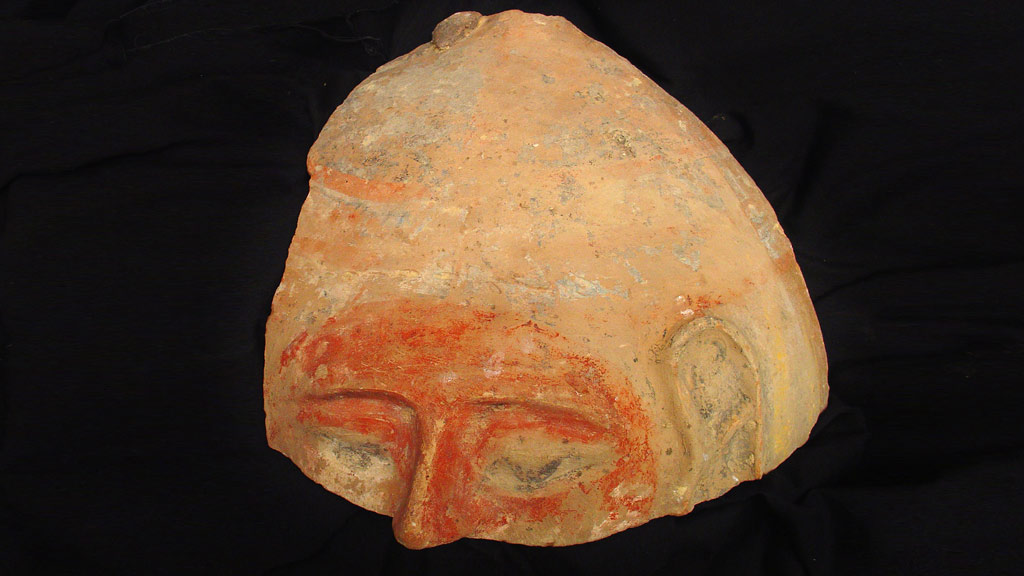 Coffin Lid Fragment Arched brows curve from a strong nose in this fragmentary funeral portrait. Traces of yellow paint can still be seen to the right of the prominent left ear. Coffins like this one are known primarily from the Middle East during a time of Egyptian occupation. Since the coffin was found in Egypt, it probably represents someone who had immigrated to Egypt from the Middle East or had familial ties there. New Kingdom Egypt, Faiyum Oasis or Abydos Earthenware and paint 1500–1100 BCE 1912.01.0035
Coffin Lid Fragment Arched brows curve from a strong nose in this fragmentary funeral portrait. Traces of yellow paint can still be seen to the right of the prominent left ear. Coffins like this one are known primarily from the Middle East during a time of Egyptian occupation. Since the coffin was found in Egypt, it probably represents someone who had immigrated to Egypt from the Middle East or had familial ties there. New Kingdom Egypt, Faiyum Oasis or Abydos Earthenware and paint 1500–1100 BCE 1912.01.0035
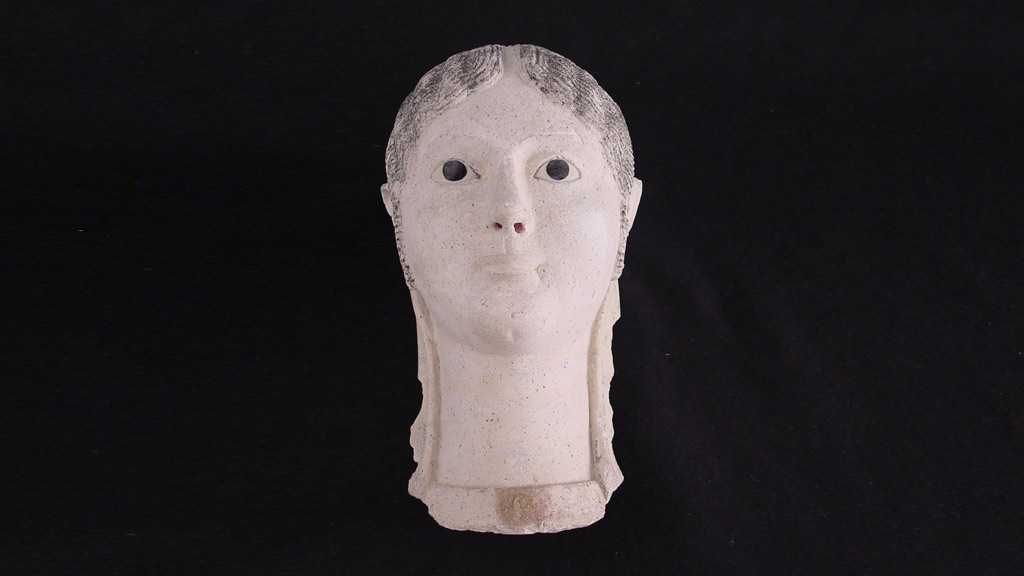 Plaster Burial Portrait Though now a bright white, this plaster portrait was once painted in vivid colors; traces of orange-red pigment inside the nostrils indicate the rich tone of the portrait’s skin. Over the centuries, ancient sculptures often lose their eyes; in this one, delicate stone inlays remain. The woman’s face combines idealized features with an individual expression and striking hairstyle. Roman Egypt, Faiyum Oasis or Abydos Plaster, stone, and pigment 100–150 CE 1926.02.0234
Plaster Burial Portrait Though now a bright white, this plaster portrait was once painted in vivid colors; traces of orange-red pigment inside the nostrils indicate the rich tone of the portrait’s skin. Over the centuries, ancient sculptures often lose their eyes; in this one, delicate stone inlays remain. The woman’s face combines idealized features with an individual expression and striking hairstyle. Roman Egypt, Faiyum Oasis or Abydos Plaster, stone, and pigment 100–150 CE 1926.02.0234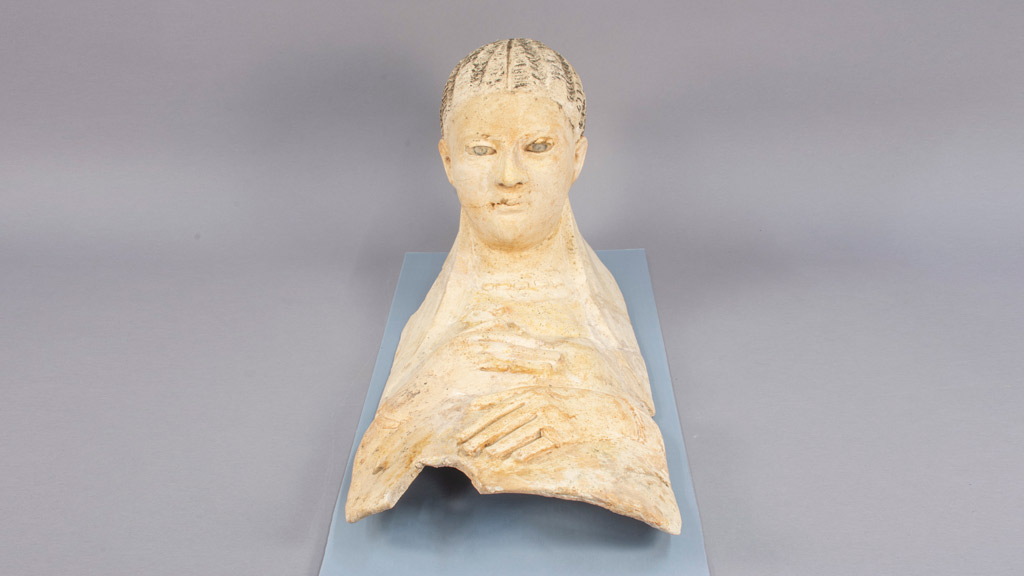 Terracotta Burial Portrait The maker of this portrait highlighted the deceased’s jewelry: a necklace, bracelet, pinky ring, and hair pin (now lost). With her head supported on a headrest, the woman is posed in sleep and also poised for rebirth. Headrests in ancient Egypt were symbols of resurrection. Roman Egypt Terracotta and paint 150–200 CE 1988.06.0001
Terracotta Burial Portrait The maker of this portrait highlighted the deceased’s jewelry: a necklace, bracelet, pinky ring, and hair pin (now lost). With her head supported on a headrest, the woman is posed in sleep and also poised for rebirth. Headrests in ancient Egypt were symbols of resurrection. Roman Egypt Terracotta and paint 150–200 CE 1988.06.0001
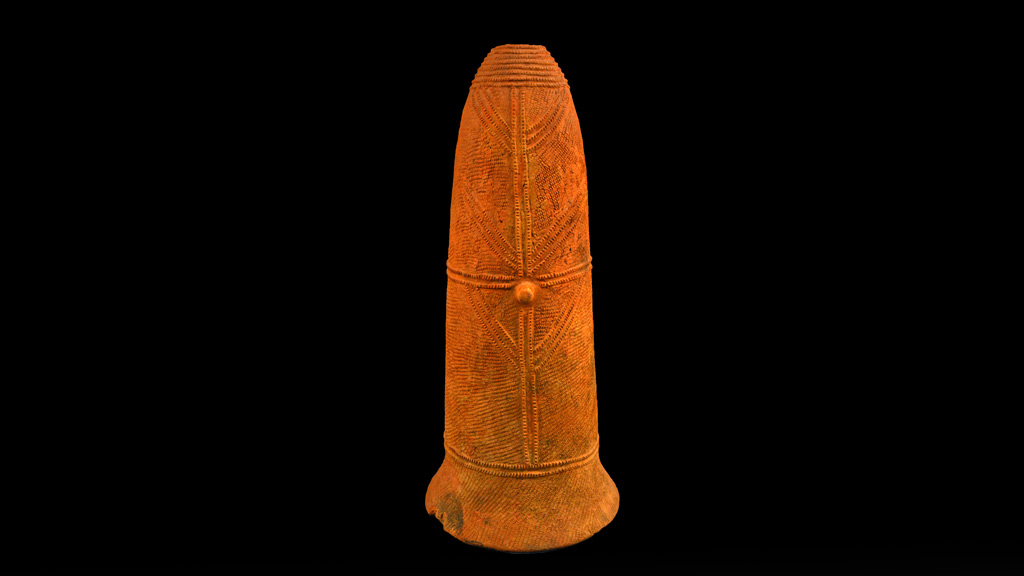 Bura Grave Urn Though abstract at first glance, this grave urn is a representation of the deceased, phallic to symbolize his gender. Etched lines represent scarification (the deliberate scarring of the body, a type of body modification popular among the Bura) while the central bump may indicate a belly button. Sometimes (though not here) the bump is perforated. This perforation could have had a practical purpose, to drain fluid from the decaying remains inside, as well as a spiritual purpose, to allow the body’s soul to escape. Like most Bura pottery, this urn was probably produced by a woman. The potter may have also sculpted a human figure to top the urn, where it is now broken. Bura peoples (modern-day Niger) Ceramic; terracotta 300–1300 CE 2001.06.0001
Bura Grave Urn Though abstract at first glance, this grave urn is a representation of the deceased, phallic to symbolize his gender. Etched lines represent scarification (the deliberate scarring of the body, a type of body modification popular among the Bura) while the central bump may indicate a belly button. Sometimes (though not here) the bump is perforated. This perforation could have had a practical purpose, to drain fluid from the decaying remains inside, as well as a spiritual purpose, to allow the body’s soul to escape. Like most Bura pottery, this urn was probably produced by a woman. The potter may have also sculpted a human figure to top the urn, where it is now broken. Bura peoples (modern-day Niger) Ceramic; terracotta 300–1300 CE 2001.06.0001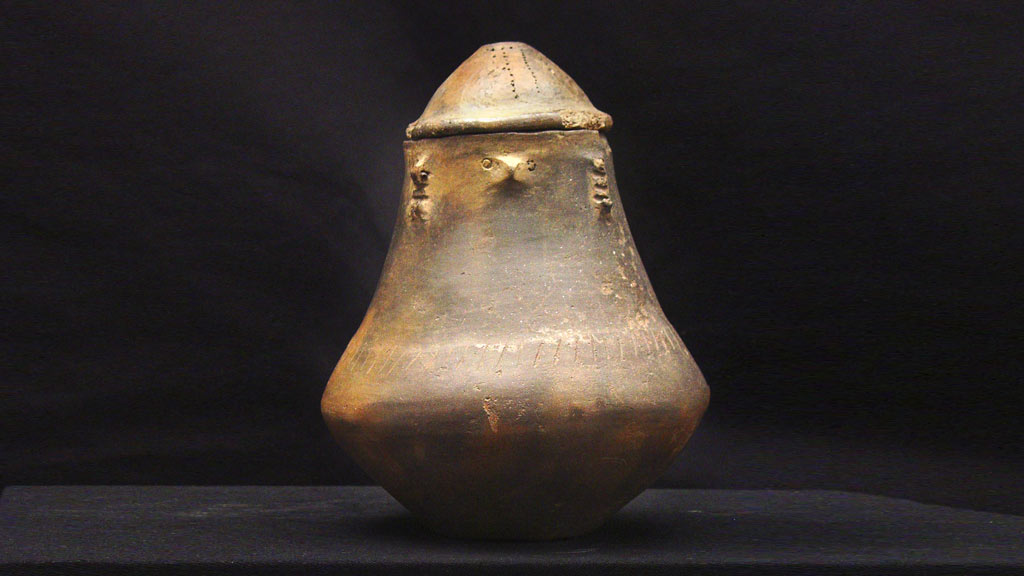 Pomeranian Face Urn This urn once held the ashes of the dead and probably represents the deceased, transformed through this representation into what scholar Katarzyna Slusarska calls an “eternal body.” The urn presents a stylized human face topped by a hat-like lid, the signature style of a culture that flourished in the Pomeranian region of modern-day Poland. Other urns of this type are decorated with personalized representations of clothing, weapons, and jewelry. The Pomeranian people who made face urns may have learned the technique from the Etruscans, a pre-Roman people of ancient Italy. Pomeranian Face Urn Culture (present-day Poland) Ceramic; stoneware 650–500 BCE 1922.07.0012A–B
Pomeranian Face Urn This urn once held the ashes of the dead and probably represents the deceased, transformed through this representation into what scholar Katarzyna Slusarska calls an “eternal body.” The urn presents a stylized human face topped by a hat-like lid, the signature style of a culture that flourished in the Pomeranian region of modern-day Poland. Other urns of this type are decorated with personalized representations of clothing, weapons, and jewelry. The Pomeranian people who made face urns may have learned the technique from the Etruscans, a pre-Roman people of ancient Italy. Pomeranian Face Urn Culture (present-day Poland) Ceramic; stoneware 650–500 BCE 1922.07.0012A–B
Cartonnage
Cartonnage is a technical term for an ancient version of papier-mâché. To make cartonnage, strips of linen or papyrus (a type of paper) were glued together with plaster to create a light, durable shell. This shell could then be painted, gilded, and inscribed.
 Cartonnage Burial Portrait This person’s serene face has been painted gold to affiliate them with the gods. In Egyptian funerary art of later periods, men were often represented as the god Osiris and women as the goddess Hathor. This binary represents only one norm in Egyptian society, which also included genders between and beyond masculine and feminine. Here the gender of the deceased cannot be determined by jewelry or hairstyle, though it may have been indicated in parts of the burial assemblage now lost. Ptolemaic or Roman Egypt, Faiyum Oasis or Abydos Linen, plaster, and paint 30 BCE–300 CE 1912.01.0004
Cartonnage Burial Portrait This person’s serene face has been painted gold to affiliate them with the gods. In Egyptian funerary art of later periods, men were often represented as the god Osiris and women as the goddess Hathor. This binary represents only one norm in Egyptian society, which also included genders between and beyond masculine and feminine. Here the gender of the deceased cannot be determined by jewelry or hairstyle, though it may have been indicated in parts of the burial assemblage now lost. Ptolemaic or Roman Egypt, Faiyum Oasis or Abydos Linen, plaster, and paint 30 BCE–300 CE 1912.01.0004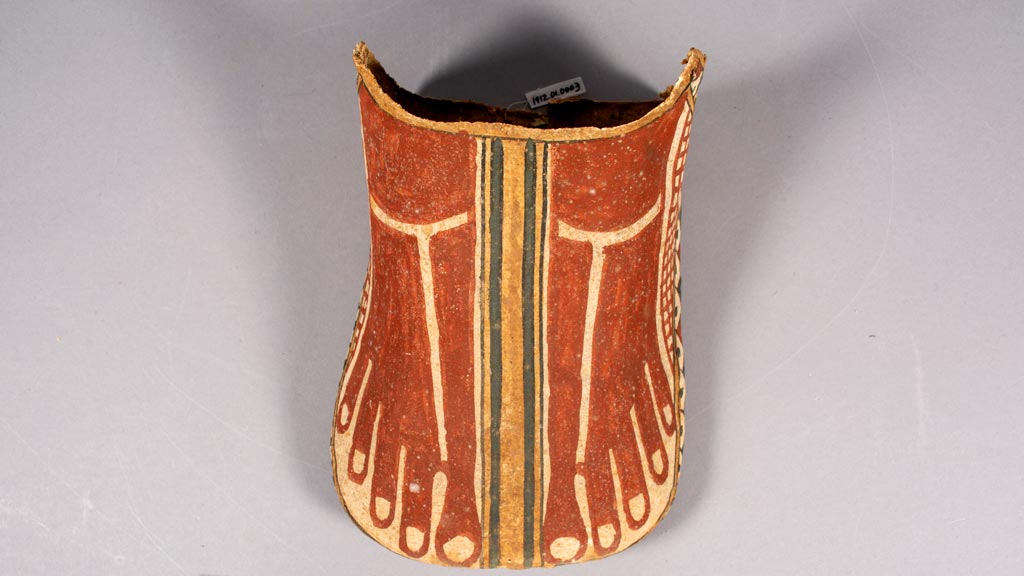 Cartonnage Foot Covering Once placed over the feet of a mummified person, this foot covering preserves colorful paint in intricate geometric patterns. The thong of a sandal can be seen between the toes. Ptolemaic Egypt, Faiyum Oasis or Abydos Linen, plaster, and paint 300–30 BCE 1912.01.0003
Cartonnage Foot Covering Once placed over the feet of a mummified person, this foot covering preserves colorful paint in intricate geometric patterns. The thong of a sandal can be seen between the toes. Ptolemaic Egypt, Faiyum Oasis or Abydos Linen, plaster, and paint 300–30 BCE 1912.01.0003